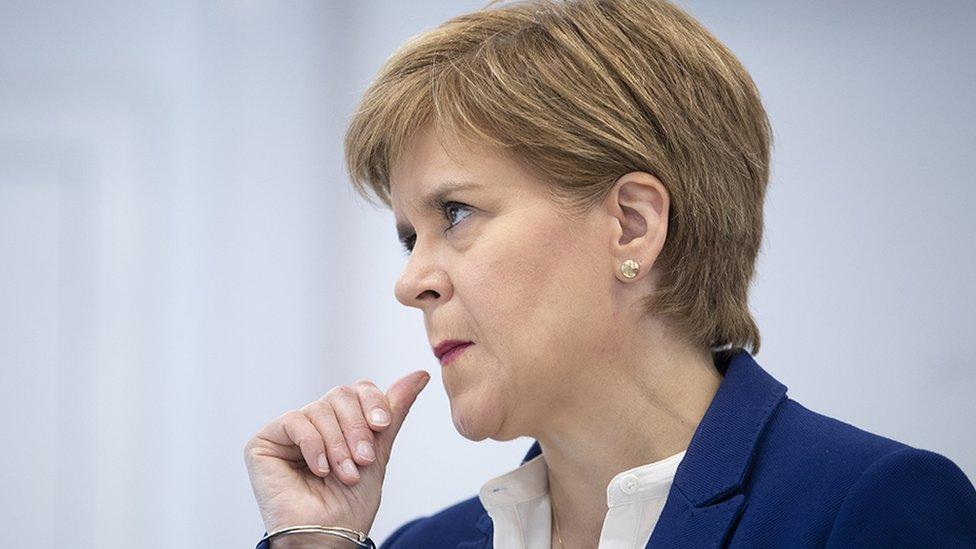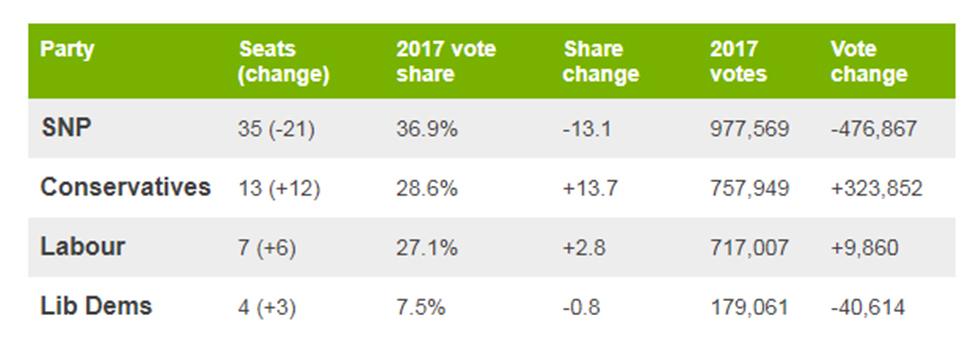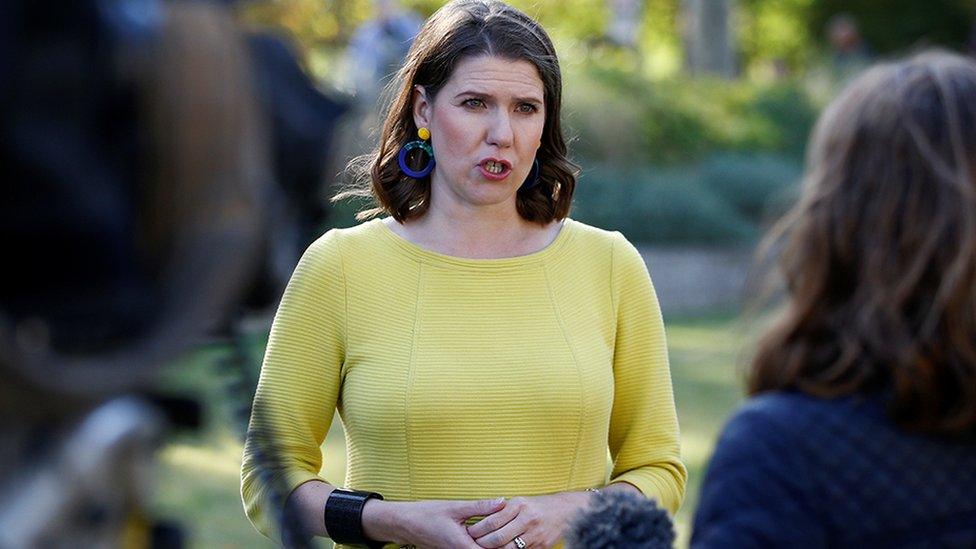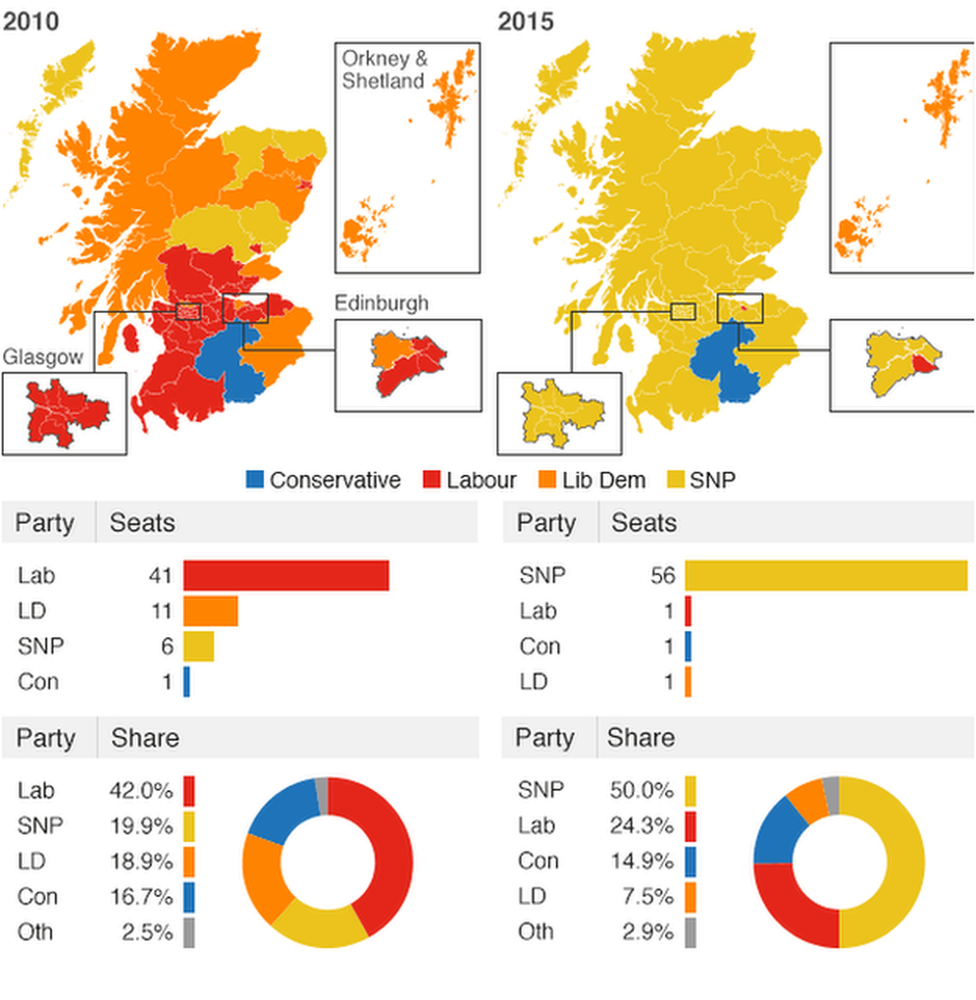Who in Scotland is looking forward to an election?
- Published

SNP leader and Scotland's First Minister Nicola Sturgeon is keen to fight a general election - but do the polls suggest good fortune?
The outcome of the last general election in 2017 proved to be something of a setback for the SNP.
The party lost 21 seats, a reverse that was widely interpreted as evidence of a rejection of the party's push for a second independence referendum. Indeed, a few weeks later Nicola Sturgeon put the party's referendum ambitions on hold.
However, according to the polls, an election this autumn could well present the SNP with a golden opportunity to repair much of the damage it suffered two years ago - and to inject new life into its campaign for Scottish independence.
Before this week, a plethora of polls, external undertaken during the spring and early summer had already suggested that the SNP were more than holding their own. On average, they put the party on 40%, up three points on its share of the vote in 2017.
Meanwhile, this week the first Scottish poll of voting intentions to be published for three months, external and conducted by YouGov put the party in an even better position - 43% of the vote, its highest share in any poll since the last election.
Conversely, polls earlier this year were pointing to a downturn in the fortunes of both the two larger unionist parties north of the border, the Conservatives and Labour.
In the wake of the Brexit impasse, the Conservatives were punished for their failure to deliver Brexit while voters lost faith in Labour because of the ambiguity of their policy on Britain's future relationship with the EU.
This turn of events was just as much in evidence in Scotland as it was south of the border.

Conservative support slipped to 20%, nine points down on what the party achieved in 2017. That 20% figure is replicated in the latest YouGov poll.
Meanwhile, while earlier this year Labour was running on average at 20%, seven points down on 2017, the latest poll suggests its rating may have sunk even further to just 15%, its worst rating since 2017.
Of the unionist parties, only the anti-Brexit Liberal Democrats' fortunes have improved - again in line with the trend in England and Wales. By the time the European election was over, the party in Scotland was recording its first double digit poll ratings for over five years.
That progress is underlined in the latest poll, which put the party at 12%.

Jo Swinson is the UK leader of the Liberal Democrats and her seat is in Scotland
The Liberal Democrats' revival should help insulate the party - including its new UK leader, Jo Swinson, in her marginal East Dunbartonshire seat - against the apparent improvement in nationalist fortunes.
But given that most of the seats they won in 2017 are vulnerable to quite a small swing back to the SNP, the fall in Conservative and Labour support is potentially enough to wipe out most of the gains that the two larger unionist parties made at the SNP's expense in 2017.
Nicola Sturgeon's party could once again dominate Scottish representation at Westminster, just as it did between 2015 and 2017.
What changed in 2015?

However, the SNP leader will not just be buoyed by the prospect that an autumn election might enable her party to increase its representation at Westminster once more.
She will also be aware of another consistent message in the polls - that support for independence has risen.
Until recently, there was little sign that the level of support for independence had increased in the wake of a Brexit debate instigated by a referendum in which Scotland had voted by almost two to one in favour of remaining in the EU.
The independence dial appeared to be firmly stuck at the 45% level that had been registered in the 2014 ballot.
How did the political map look in 2017?

But that has not been the picture since the spring. On average the polls have put support for independence (after leaving aside Don't Knows) at 49%, including one from Lord Ashcroft that actually put Yes narrowly ahead.
This movement too is confirmed by the latest poll, which again put Yes on 49%, external.
While that figure does not suggest that the SNP could be confident of victory in a second independence referendum, it does mean that unionists could not be confident of doing so either. Scotland now seems to be divided almost equally down the middle on the constitutional question.
Moreover, there seems to be increased support for holding a second ballot.
The Brexit factor
Little more than 18 months ago, opponents of having another independence referendum within five years outnumbered supporters by 54% to 36%. Now, according to YouGov the figures are 44% and 45% respectively. A similar trend has also been identified by Panelbase.
The Brexit debate seems to have played an important role in the swing in favour of Yes. The increase in support for independence has taken place entirely among those who voted Remain.

Nicola Sturgeon celebrates the SNP's victories at the 2015 general election
In polls taken in the second half of last year those who voted Remain were divided equally between supporters of Yes and backers of No. In this year's polls, including the most recent, support for Yes among Remain supporters has averaged 57%.
Conversely, at around a third, the level of support for Yes among those who voted Leave has been little different in this year's polls (32%) from what it was last year (34%).
It looks as though some voters in Scotland who voted Remain have been persuaded by the recent turn of events on Brexit to switch in favour of Yes.
Whoever becomes prime minister after an autumn election could well not only face the challenge of resolving Brexit, but also of how to handle a SNP Scottish government that - whatever happened two years ago - now feels newly emboldened in its demands for another independence referendum.
Sir John Curtice, external is professor of politics at Strathclyde University, and senior fellow at ScotCen Social Research, external and The UK in a Changing Europe, external.